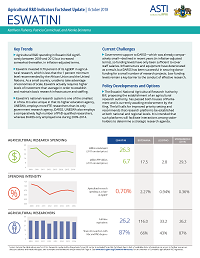Authors:
Kathleen Flaherty, Patricia Carmichael, and Nienke Beintema
Year:
2018
Publisher
International Food Policy Research Institute and The Department of Agricultural Research and Specialist Services (DARSS)
Back to:
KEY TRENDS
- Agricultural R&D spending in Eswatini fell significantly between 2009 and 2012 but increased somewhat thereafter, in inflation-adjusted terms.
- Eswatini invested 0.70 percent of its AgGDP in agricultural research, which is less that the 1 percent minimum level recommended by the African Union and the United Nations. As a small country, unable to take advantage of economies of scale, Eswatini actually requires higher levels of investment than average in order to establish and maintain basic research infrastructure and staffing.
- Eswatini’s national research system is one of the smallest in Africa. It is also unique in that its higher education agency, UNESWA, employs more FTE researchers than its main government research agency, DARSS. UNESWA also employs a comparatively high share of PhD-qualified researchers, whereas DARSS only employed one during 2009–2014.
CURRENT CHALLENGES
- Government support to DARSS—which was already comparatively small—declined in recent years (in inflation-adjusted terms), so funding levels have only been sufficient to cover staff salaries. Infrastructure and equipment have deteriorated as a result, but DARSS has been successful in securing donor funding for a small number of research projects. Low funding levels remain a key barrier the conduct of effective research.
POLICY DEVELOPMENTS AND OPTIONS
- The Eswatini National Agricultural Research Authority Bill, proposing the establishment of an agricultural research authority, has been passed and is awaiting parliamentary debate. The bill calls for improved priority setting and recommends that research platforms be established at both national and regional levels. It is intended that such platforms will facilitate interactions among stakeholders to determine a strategic research agenda.

